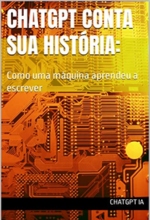Artificial Writing – Marcos Manoel Silva Severiano’s (Urca) review of “ChatGPT conta sua história: Como uma máquina aprendeu a escrever” by Chatgpt IA

Abstract: ChatGPT conta sua história: Como uma máquina aprendeu a escrever, it is an innovative work of 2023, written by AI ChatgPT itself. In 46 pages, it details its evolution and the mechanisms of neural networks, offering a unique perspective on how he learned to write and its challenges in imitation of human language.
Keywords: Artificial Intelligence, ChatgPT, Autobiography, Computational Learning.
ChatGPT conta sua história: Como uma máquina aprendeu a escrever, it was written by Chatgpt AI, Artificial Intelligence (AI) tool created by OpenAi, and published in Kindle ebook format in 2023. The book, throughout its own 46 pages, it addresses the chatgpt development trajectory comprising its processes of creation, training, modeling, as well as its future possibilities of use. As a book author, this chatbot tool with a pre-trained generative transformer presents, for the first time, a literary work produced by an AI about herself.
 ChatGPT is an acronym for Generative Transformer Generative, or in pre-formal generative transformative Portuguese, which consists of a neural architecture capable of simulating data processing in the construction of quick responses to the conversational context. The tool was modeled from the use of mathematical data capable of turning words into vectors, learning more complex characteristics in feed-foward layers (neural networks), having reached public use in 2022. Although recent, the tool already It has undergone updates and reformulations, having its most current version in the ChatgPT-3 version. The company OpenAi, its creator, produced the tool with databases from various sources, to enable the greater degree of refinement in the machine’s readings and understandings about human language, leaving it versatile for this “real simulation”. Still in 2022, developed computational learning was in testing, gradually being made available for public uses. This neural network debuts, now in 2023, as a book author, including this one over herself, in a human attempt of self -perception. The book has five chapters, as well as an introduction and a conclusion.
ChatGPT is an acronym for Generative Transformer Generative, or in pre-formal generative transformative Portuguese, which consists of a neural architecture capable of simulating data processing in the construction of quick responses to the conversational context. The tool was modeled from the use of mathematical data capable of turning words into vectors, learning more complex characteristics in feed-foward layers (neural networks), having reached public use in 2022. Although recent, the tool already It has undergone updates and reformulations, having its most current version in the ChatgPT-3 version. The company OpenAi, its creator, produced the tool with databases from various sources, to enable the greater degree of refinement in the machine’s readings and understandings about human language, leaving it versatile for this “real simulation”. Still in 2022, developed computational learning was in testing, gradually being made available for public uses. This neural network debuts, now in 2023, as a book author, including this one over herself, in a human attempt of self -perception. The book has five chapters, as well as an introduction and a conclusion.
In the introduction, AI presents an overview of its creation by a team of researchers linked to OpenAi, which is recognized for the development of solutions about Deep Learning (Deep Learning) and Machine Learning (machine learning). This team was responsible for creating a language model called ChatgPT. In addition, the tool’s development architecture is described from the relationship between the transformers layers (attention and feed-force) and the vector (vector), which makes up the computational logic of its operation so that the reader can understand the reader tool usabilities. In this session, AI, is still dedicated to presenting the steps taken so that this tool can simulate the maximum of a human neural behavior relationship, developed in 5 steps: 1. data collection; 2. Model architecture; 3. Training; 4. Fine adjustment and 5. Evaluation and improvement. This introductory chapter, in the final part, explains the main differences between this AI model for the other models in the market, presenting its differentials based mainly on the thin adjustment capacity of the texts worked, the processing speed and the continued learning capacity for the proceedings itself.
In the Chapter Training and Fine Adjustment, the tool begins to specify its training process more through a technique called “Non -Supervised Learning”, in which exposure to various texts enables the improvement of the ability to predict words based on sequential formats used . In addition, the adjustment of this text reading mechanism for some specific tasks is also addressed, such as writing poetry. Since AI is a computational language, it performs this automation turning to movements such as fine tuning, transfer learning or incremental training. Each of these enables tool adjustments to increase its accuracy throughout the developed activity.
These first two chapters develop mainly around the logical computational part necessary for the development of a tool such as chatgPT, with a technical language, full of computational jargon and without so much management in the way of exemplifying some of these actions, lacking from a sensitivity to the reader not started in the area.
The ChatgPT chapter in action is dedicated to presenting the features derived from the tool. In a versatile and didactic way, AI builds examples for each of its main purposes, such as text generation, automated answers, dialogue generation, feelings analysis, among others. In total, eight ways are presented, so that the reader understands the tools of the tool. From this chapter the writing is more accessible to readers, mainly by turning to action against the theory that composes this neural network.

The Chapter Limitations and Challenges presents a writing very similar to the previous one, but now turning to the main challenges found by the tool throughout your journey to date. Six of these limitations stand out: 1. Combination understanding; 2. improved knowledge; 3. Comprehension of figurative language; 4. Understanding of complex topics; 5. Cultural differences; 6. Ethical responsibility. Each of these topics is presented very directly and without much detail. The writing of this chapter is directly associated with the next chapter, entitled Next Steps, where the future of chatgPT is reflected in a few paragraphs, highlighting the constant improvement exercise that the tool has, besides the possibilities of interactions triggered by other users who come to interact with her. The aspects of legal and political treatment about its use is cited without major discussions about it. These two chapters, despite the easy and affordable language, are very superficial, without demonstrating the complexities in the face of the challenges and future projections of the tool itself.
In conclusion, AI summarizes everything it wrote in each chapter, in a very synthetic and direct way. The optimistic tone about the future of the tool and simulas appears again, leaving the propaganda done throughout the work. Common elements of biography and/or autobiographical writing, such as the time, space, contexts, characters involved, are suppressed for an indifferent third person perception before the approached subject.
Although the work meets its proposal, telling the story of ChatgPT, the idea of a self -narrative, also proposed, is frustrated by the absence of a first person writing, self -reflection movements and a writing, common in biographies, sensitization from the reader to the biographed subject. With a writing that migrates from a dialect to initiates in the technological world to naively simple and emotionally writing, after the second chapter, the work leaves something to be desired, not being able to meet a more specialized audience, who wanted more technical data, nor To a lay audience, which is removed from the text in the early chapters by the complexity of used jargon. The innovative character, of being a work written by an AI about itself, is the only attraction, serving to invite readers to a journey that does not correspond to the proposal raised by the title of the work.
Summary of ChatGPT conta sua história: como uma máquina aprendeu a escrever
- Introdução ao ChatGPT
- Treinamento e ajuste fino
- ChatGPT em ação
- Limitações e desafios
- Próximos passos
- Conclusão
Reviewer
 Marcos Manoel Silva Severiano has a degree in History (URCA), Bachelor of Psychology (Unileão), with specialization in School Management (Uncomplicated College) and Teaching of Higher Education (Unileão), Master’s student in History by Profhistory (URCA). Develops activities in the areas of Education, History and Psychology, working with school management, pedagogical direction and pedagogical coordination, as well as a high school teacher at the state and private school in the state of Ceará. It is also a creator of digital content through the paradigatata channel on YouTube and Spotify. Social Networks: MarcosRua47; ID Lattes: http://lattes.cnpq.br/5429477567940296; Orcid ID: https://orcid.org/0009-0009-0876-624x; Email: marcosmanoelsilvaseveriano@gmail.com.
Marcos Manoel Silva Severiano has a degree in History (URCA), Bachelor of Psychology (Unileão), with specialization in School Management (Uncomplicated College) and Teaching of Higher Education (Unileão), Master’s student in History by Profhistory (URCA). Develops activities in the areas of Education, History and Psychology, working with school management, pedagogical direction and pedagogical coordination, as well as a high school teacher at the state and private school in the state of Ceará. It is also a creator of digital content through the paradigatata channel on YouTube and Spotify. Social Networks: MarcosRua47; ID Lattes: http://lattes.cnpq.br/5429477567940296; Orcid ID: https://orcid.org/0009-0009-0876-624x; Email: marcosmanoelsilvaseveriano@gmail.com.
To cite this review
ChatGPT conta sua história: Como uma máquina aprendeu a escrever. SDT: Open.IA, 2023. 46p. Review of: Severiano, Marco Manuel Silva. Artificial writing. Crítica Historiográfica. Natal, v.3, n.13, Sep/Oct, 2023. Available at <Artificial Writing – Marcos Manoel Silva Severiano’s (Urca) review of “ChatGPT conta sua história: Como uma máquina aprendeu a escrever” by Chatgpt IA – Crítica Historiografica (criticahistoriografica.com.br)>.
[Print-me alt = “Print or download this review in PDF” Target- “Body”]
© – The authors who publish in historiographical criticism agree with the distribution, remixing, adaptation and creation from their texts, even for commercial purposes, provided that the proper credits are guaranteed by the original creations. (CC by-SA).








